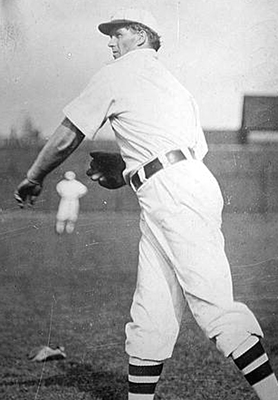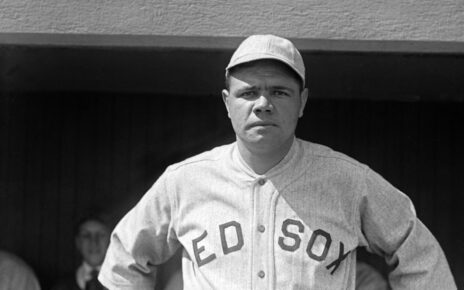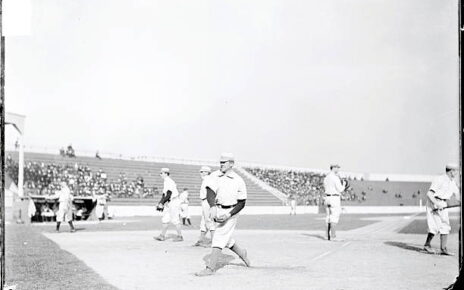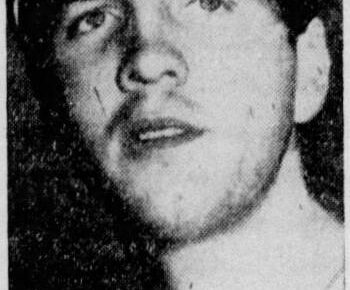Right from the get-go, Otto Hess was a two-way player. Okay, okay, okay, not from the very get-go, but in his second year of professional baseball he took on the two-way player cause. It’s unclear what caused this to be the course of action because in 1902 with the American League’s Cleveland Bronchos he was an abysmal hitting pitcher. Still, come 1904 Hess wasn’t just dabbling in the two-way game, he had jumped in feet first and was ready to leave his mark on the baseball world.
It’s tough to say what kind of mark Hess left in his 1903 Western League season with the Kansas City Blue Stockings. We know that he pitched in 40 games and played the field in 7, but outside of him posting a .229 BA and walking 123 hitters not much is known from that season. Still, that is the season when his manager, Kid Nichols, decided Hess was going to play both ways. When he returned to Major League Baseball in 1904 that is exactly what Hess did, albeit to diminishing returns.
Returning to the rechristened Cleveland Naps Hess appeared in 21 games on the mound, starting 16, and posted an ERA of 1.67, had 4 shutouts in 15 complete games, a WHIP of 1.090, and an equally impressive FIP of 2.46. His ERA+ of 153 was good enough for fifth among all qualified pitchers. In 12 games in the outfield, the lefthanded hitter slashed .120/.146/.160. In 104 plate appearances, he walked only 3 times, struck out 27 times, and amassed a stellar OPS+ of -3. His rWAR ended up being a combined 0.3, and there is absolutely no reason why Naps manager Bill Armour took one of the better pitchers in the league and tried to make him play the field when he so clearly wasn’t any good with the stick.
1905 rolls around and Armour is gone, but apparently neither Bill Bradley nor Nap Lajoie bothered to pay attention because Hess remained a two-way stalwart. In 28 games in the outfield, he slashed .254/.291/.347 with a positive OPS+ of 101. Not exactly an earth-shattering offensive season, but compared to 1904 it was as if the sky hard parted and aliens beamed the ability to hit into Hess’ body. In exchange, Hess must have sold some of his pitching prowess because he seriously regressed to an 83 ERA+, 1.175 WHIP, and 3.16 ERA. On the surface, he appeared to be a good pitcher but he wasn’t, as his league-leading 18 wild pitches can attest. Hess finished 1905 with an rWAR of 0.7, a slight uptick on his previous season’s total.
Major league teams had enough of the Switzerland native’s two-way attempts and left him firmly in the role of a pitcher for the rest of his career with only a smattering of positional play most seasons. In the minors, well, they were more willing to grant Hess continued chances at regular two-way play. In 1909 the 6’1 Swiss played with the New Orleans Pelicans of the Southern Association. There aren’t many stats available for that season. It’s known that he pitched in 38 games and played somewhere in the field for an additional 11 games. He went 18-12 on the mound while hitting .223 that year. The Pelicans had seen enough and were content with limiting Hess to one game in the field in 1910 and to pitching exclusively in 1911.
Fast forward past four seasons spent as a middling pitcher and extremely rare position player with the National League’s Boston club (If this is the first time you are encountering this in my writing, I do not refer to team names that are racist as a policy) and in 1916 the Vernon Tigers of the Pacific Coast League decided a never been successful two-way player just needed another shot at both hitting and pitching. It went about as one would expect, Hess commanded a 2.69 ERA and 1.390 WHIP in 37 games as a pitcher, but managed a .322 BA and .422 SLG in 14 games in the field. He didn’t have any power, and he wasn’t actually a good hitter, but I can at least see how his surface numbers would give the allusion that he was worth a two-way shot in 1916.
In 1917 Hess was back in the SOUA, only this time with the Atlanta Crackers. In his final professional season, he posted a 4.84 RA/9 and 1.446 WHIP in 186.0 innings pitched over 28 games toeing the rubber. He saw the field for an additional 14 games, unknown at what position but most likely in the outfield, and hit .263 with a .363 SLG over 80 at-bats. A dud ending befitting what had been a dud of a two-way player.
Hess ended his pro career having wasted many a year providing mediocre to well below average two-way play. I can’t help but wonder if Hess could have engineered himself a decent career as a pitcher if he had just focused on pitching and pitching alone. Hess shot his shot, but it wasn’t a good shot and it should have ended around 1904. Instead, he kept shooting the same misguided shot in many a season to follow, and his career suffered for his continued attempts to play both ways.
Lead photo courtesy of Unknown – National Baseball Hall of Fame Library




